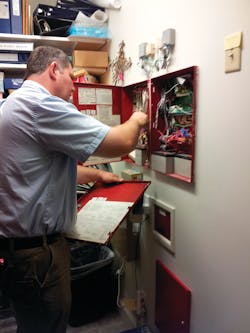Across the technology contracting landscape, the story’s the same: margins on hardware continue to plummet, leaving solution providers struggling with cash flow.
It doesn’t have to be that way, and it is not all that difficult to make the necessary changes that will enable you to increase your recurring monthly revenue (RMR). First consider: once the installation is over, what is your role? If you have gone blank, then you have not considered the tangible — and intangible — value associated with offering service and maintenance agreements.
Annual inspection agreements are great RMR, especially in meeting fire and life safety codes and standards; however, if you want to add even more value, then you have to shift your way of thinking to that of a service provider.
That’s really what we are, concurs Jamie Orvis, president of Security Solutions Inc., a 35-year-old Five-Diamond CSAA UL monitoring and service provider in Norwalk, Conn. “Offering service and maintenance agreements adds value to our company,” he says. “The basic residential burglar alarm has been commoditized and the margins are slim. In this highly competitive marketplace, the only way to differentiate is through service.”
Orvis urges integrators to get service and maintenance agreements with every contract. “It is especially important to have these agreements in the commercial environment, because it is easy for them to make it a line item in their budget,” he says. “Make it a companywide priority to obtain service and maintenance agreements if you want to make it work.”
The entire sales team has to be well-versed in the benefits of these agreements, be able to communicate value to the customer, and of course, understand how they will be compensated. Some integrators keep it simple and pay a flat fee on activation or signing by the customer, or, pay the same commission as with a regular RMR signing. The compensation plan could also offer some multiple of the additional monthly RMR sold for a fixed period, say three to four months. Make sure to implement a charge back policy to the salesperson if the customer cancels the contract early. Also remember not to establish any “in perpetuity” sales compensation plan; make it a one-time-only payment.
Variables in Pricing the Service
According to Orvis, one of the challenges is setting prices for the agreements, and that is usually based on an analysis of each individual client, the extent of their system and the nature of the facility. For example, a small retail operation with traditional business hours vs. an industrial process plant with 24/7 operations would definitely constitute different monthly charges.
“Systems are just all over the board as far as configuration and initial expense,” Orvis says. “You might have 300 employees for an access control system, but they are all using the same door. Or you have a 15-door system with only 30 employees. Expect some contracts to be more time-consuming than others, but with enough of these inked agreements, they will balance each other out.”
Some 70 percent of Security Solutions’ customers have service and maintenance contracts.
Where to Start
The idea is to develop a business plan and execute it, outlining all details. Include the entire team, if possible, in the process. Decide what the agreements will consist of and how you will position and package them. What you call these plans and how you craft them is up to you, but the key is to add value.
Some in the industry prefer to call them preventative maintenance agreements, or proactive service plans. Many include different packages with specific inclusions, such as Platinum, Gold, Silver, etc. — pricing each accordingly. Or they simply provide tiers or levels, such as Level 1 or Tier 1, again providing the specific areas of coverage. Some companies include product replacement for the first year or to coincide with the manufacturer’s warranty. After that, they might give customers with service and maintenance plans a discount on equipment, labor and service calls. It all depends on you, your market and your costs, especially loaded labor.
American Fire & Security/The Security Girl of Dayton, Ohio, has been offering service contracts to all its customers for about three years, achieving about an 85-percent success rate at the initial time of the sale. If the customer doesn’t purchase one, they can add it at any time.
“We offer it as a value-added service,” says Erica Tucker Wood, chief security officer. “It does come up from time to time that they don't need it because the equipment is new or because they feel they won't have issues; however, just by pointing out the added value, most of those issues are overcome or they add on the service contact after the one-year manufacturer’s warranty expires. Right now, we only have a handful of clients who do not have some sort of service contract with us.”
Wood says the service contract offers a few different options, depending on the individual client’s needs. They can have all-inclusive parts/labor, one just for services, and one for inspections only, and range anywhere from $7 to $200 per month, depending on the size of the system and the type of coverage the client needs. The company has been able to increase its RMR by approximately 70 percent just by offering service contracts.
“We have had several clients utilize our services because we offer a service contract and our competitors do not,” Tucker Wood says. “It is easier for them to add the cost of the contract into their budget than to have to pay for it all at once. A few of our clients have looked at it like level billing (our local power company offers this) so they always know what they are going to pay — no surprises.”
Getting Away from the ‘Reactive Model’
Audio/visual integrators have also delved into offering service and maintenance plans, looking for new ways to garner RMR streams. RAVE Audio Visual of Aurora, Can., began offering proactive service agreements several years ago. Dane Rife, operations manager of the family-owned business near Toronto, was astounded when he did an analysis of just how much more RMR the company was generating from these contracts. He says the company has grown its RMR by some 914 percent since initiating the offerings.
Before launching the agreements, Rife was like many other technology solution providers, installing systems and moving onto the next — what he calls a reactive service model. He developed a business plan for the agreements, tailoring it for each customer and their type of system. He also reworked their systems quote sheet so there’s a recommended plan customers can select from.
“We created the contract so that the price automatically populates with the proactive service contract options and costs,” he says. The plans range in length from one to three years, and it keeps RAVE AV front-and-center with the client.
Quarterly proactive service agreements are offered in standard and priority “flavors” in terms of one to five years. The standard plan includes four service calls, telephone support and next-day, on-site tech visits as well as firmware and software upgrades. The priority plan includes everything in the standard plan, but instead, on-site tech visits within four hours of the call. The priority plan also includes loaner equipment that is similar to existing equipment. “We swap it out and back in again when the new replacement equipment comes in,” Rife says. “Repairs and parts are included. We also offer unlimited service calls outside the four preventative maintenance visits.”
Today’s sophisticated electronics need and depend on a technology solution provider to keep them up and running at all times. Service and maintenance agreements are an important part of the credo for 24/7 operation. And for integrators, they add regular cash flow through additional RMR, boosting the overall value of the business at the same time.
Deborah L. O’Mara is the owner of DLO Communications and a veteran of the systems integration industry. Reach her at 847.384.1916 or [email protected].
Sidebar:
What to Include in Your Plans
Here are some possible service and maintenance inclusions for three different types of systems
Home Automation
- General diagnostics and health checks of main control and connectivity.
- Software updates, upgrades and operating patches.
- Check of individual system components, such as energy management controls and devices.
- Verify automated relays and controls to lighting, spa tubs, garage door and other integrated components.
- Fine-tuning and adjustments based on normal system use.
- Provide complete report of all tests with results and detail potential subsequent action.
Video Surveillance
- Check all hardware, software and system monitoring for general health, conducting video ‘tours’ of each camera to make sure each is functioning.
- Verify all PTZ controls and fans; inspect housings, connections and wiring especially outdoors, which may require other equipment such as lifts and ladders.
- Verify the health, operability and current capacity of all storage devices, including cameras storing images on the edge (SD cards), NVRs, DVRs and other servers. Assess hard drive functionality and capacity.
- Verify overall storage data and operability, including time/date stamp, recording parameters such as frames per second, etc.
- Assess battery health, longevity and overall operation.
- Check camera focus with an eye to the environment such as overgrown foliage or new structures. Readjust where necessary; clean, inspect and replace camera lenses where necessary.
- Check for software updates, patches and other upgrades.
- Configure/adjust rules for analytics and also, integration with access control or other peripherals.
- Provide complete report of all tests, results and subsequent action.
Access Control
- Assess current level of general managed services with customer; who performs what (issue cards, add or delete users, adjust permissions for physical and logical access control)?
- Check wiring and terminations and wireless networking/devices, looking for signal strength and optimum line of sight; check all antennas.
- Stock and replace cards.
- Check main control unit and all edge devices, including keypads, readers, motion sensors, occupancy sensors and other integrated devices such as CCTV cameras.
- Print activity reports and event logs for customer, customizing where appropriate for the client.
- Initiate software updates, application programming interfaces.
- Check system batteries and longevity for wireless systems; assess UPS functionality.
Other Notes
Be sure to provide detailed reports outlining exactly what was part of the service and maintenance plan, what was checked and what the results and possible recommendations for upgrades, new components and devices.
Indicate on the agreement whether the service and maintenance will be provided remotely or on site. For onsite service, detail whether the response is 8-5 Monday through Friday, 24/7, or same day, or other parameters for response time depending on the level of service provided.
Don’t forget equipment warranties. Intrusion panels generally have a one-year warranty, while a video surveillance camera may be covered for three to five years.


